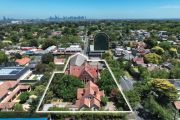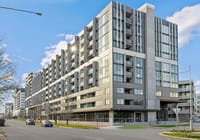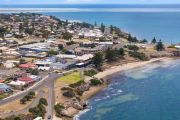
'We're taking them on': the caravan parks getting a luxury makeover
Caravan and camping parks have long been a big part of the traditional Australian holiday scene but many are now undergoing glamorous reboots and redevelopments to attract fresh, and better-heeled, guests.
“A lot of people have always had a phobia about them, seeing them as bogan,” says Tony Mayne, the owner of one holiday park in which he’s invested $10 million over the past 10 years.
“They see them as being a poor brother to the hotel or resort industry. But that’s not true, and now we’re taking them on. The old mentality about us appealing to a lower socio-demographic group is a thing of the past. The kind of demographic now coming to us is from a higher economic group because the industry is changing so significantly.”
His park, Sunshine Resort in the mid-north NSW coastal town of South West Rocks, is a case in point. He’s just launched seven two-storey luxury villas, Ngurra Lodges, each fitted out with leather lounges, modern artwork and three TVs, with prices starting at $490 a night. They’re in addition to the permanent ‘glamping’ tents he introduced last year.
“The old guard of park owners across the country are now being replaced by a far more energetic, creative new breed of owners,” says Mayne. “They’re trying different things to the point where this sector of the holiday industry is a huge and growing sector and is such a hot market.”
Official Tourism Research Australia figures show that 32.2 million nights were spent by Australians in caravan parks and commercial camp grounds during the year ending June 2017. Caravanning nights were up by 12 per cent to 13.4 million, and motorhome nights up 17 per cent to 2.2 million.
Numbers have grown year-on-year for the past 15 years, according to Theo Whitmont, president of the Caravan and Camping Industry Association (NSW).
“People expect more and we are delivering more,” he says. “There’s been a fantastic resurgence in holiday parks.
“Over the decades they always offered good-value family holidays but we are now seeing a significant amount of reinvestment in their infrastructure. Operators are putting in five-star villas, high-class tents and quality facilities like playgrounds, pools and outdoor cinemas. Nowadays you can offer a better level of comfort than you’d get at home, plus all the connections – with themselves, with nature and with other travellers.”
In turn, growing customer demand for stays in holiday parks is spurring still more investment in its commercial real estate. Property developer Bernie McGovern, for instance, also invested $10 million from his family business into developing the first new greenfield caravan park in Queensland since the 1970s.
His 10-hectare Rivershore Resort near Maroochydore on the Sunshine Coast, on the site of a former sugarcane farm, opened last year.
“It’s been unbelievable,” says McGovern, whose parents did a caravanning lap around Australia to provide the research needed for the setting up of the park.
“We’ve been open for 13 months now and we’ve gone from 16 staff to 54 staff, and our 100-seat restaurant and bar is going gangbusters.
“I think there’s always been a perception that caravanners and campers are at the lower end of the socio-demographic scale but we’ve proven that’s completely wrong.
”My parents can afford to fly first-class around the world, but they love to go out in their caravan and enjoy a sociable time. It’s a huge growing market, especially for families.”
As well as larger caravan sites to fit the bigger, modern caravans, he has luxury 84-square-metre, self-contained glamping safari tents, from $230 a night on weekdays and $270 a night on weekends. The resort itself also has a pool, kids’ pool, play areas, a gym, café, landscaping and plans for a waterpark in the future.
“Glamping is becoming increasingly popular with holiday makers and RV (recreational vehicle) tourism is a $7 billion tourism in this country, so we’re tapping into some very popular and lucrative tourism markets,” says McGovern.
Glamping has an enthusiastic and growing fan base in Australia, with such places as Paperbark Camp in Jervis Bay on the NSW south coast, Longitude 131 at Uluru in the Northern Territory and, in Western Australia, the Karijini Eco Resort in the Hamersley Range and Sal Salis Ningaloo Reef. But holiday parks are now keen for a share.
On Queensland’s North Stradbroke Island there are 12 new permanent glamping eco tents about to be opened in December in bushland at Minjerriba Camping, near Point Lookout on the north coast of the island, a short walk to the beach. Featuring queen-size beds, linen, an outside deck with hammock, ceiling fans, tables and chairs, opening rates start from $149 a night.
Hugo Johnston, who previously introduced flash camping to Cooinda Lodge & Camping Grounds in Kakadu, says everyone now sees the potential for introducing more upmarket accommodation options to traditional sites.
“We’re very excited about this,” says Johnston, who launched regular glamping tents on North Stradbroke Island last year, too. “We’ve found people absolutely love glamping and it’s also attracting the marginal campers who say they won’t go anywhere without a decent bed. We’ve been full every weekend since they started, and the eco tents will be another step up again.
“Nature-based tourism is a huge trend and it’s where we want to move to. We’ve even put Wi-Fi into a couple of our campgrounds and 90 per cent of people were pleased, and only 10 per cent of people said they were camping to get away from that!”
With so many novel attractions now being added to sites – like a fishing trawler converted into a pirate ship at Sunshine Resort, with regular shows and characters in costume wandering around “like a mini-Disneyland”, says Tony Mayne – the growth in their popularity looks set to continue.
“I’m in a working group, with a consultant engaged though the Big 4 Holiday Parks group, that’s targeting the inbound market from overseas too,” says Mayne.
“Everyone’s after a real grassroots Australian experience and we can offer that.
“There are still elements around of those old daggy and down-at-heel parks but they’re becoming fewer all the time, with the top 10 per cent of parks now becoming destinations in their own right.”













